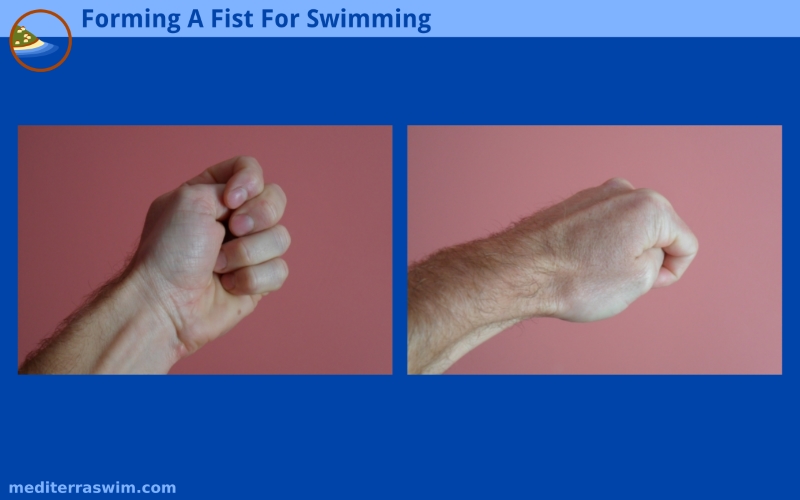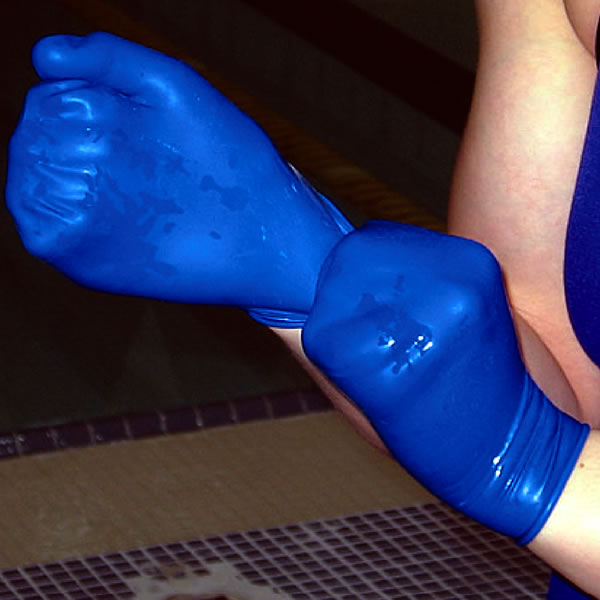by Admin Mediterra | Sep 24, 2020 | Skill Learning
Fist swimming is the opposite of swimming with hand paddles. Rather than expanding the surface area of the hand with paddles, fist swimming reduces the surface area of the hand.

Why would a swimmer want to do this?
To force your body to figure out how to get a better grip on the water using the entire forearm, not just the hand. This kind of constrained activity is called a ‘self-limiting’ exercise in therapy lingo. The idea is to reduce capability in one way in order to (lovingly) force the body to figure out another way (a better way) to do the task.
By reducing the surface area you are urged to use more of the arm to get a sufficient grip – this is strengthening your motor connections and your muscles in precisely the way you want them to be used while swimming.
In a 25 (m or y) pool fist swimming might increase your SPL by +2. But it is a great exercise to attempt to lower your SPL with fist swimming.
It is important that you form the fist with as little tension in the hand as possible. Tension will reduce the sensitivity in your hand and arm, making it harder to feel the water. You may experiment with placing a small object in your hand to hold, or keeping your thumb inside or outside the grip of your fingers.
To allow complete relaxation in the hand you can purchase actual ‘fist-gloves’.

Fist gloves are nice in this regard, but the can break and wear out quickly. So, you might be motivated to either make your own fist or to invent your own fist-gloves out of something less expensive.
by Admin Mediterra | Sep 23, 2020 | Gear
Can I or should I use hand paddles?
With every training device we recommend that you apply some basic principles. You can read more about this in Guidelines for Using Swim Training Devices.
The short answer is: No.
There is possibly a way to train with hand paddles that would allow the swimmer to carefully train the connections through the body and activate muscles in a certain pattern without putting undo strain in the shoulder joint, but we never see anyone using them this way. Paddles seem to overwhelmingly urge swimmers to pull on the water in a way that is de-training the kind of whole body connection we are working so hard to establish. Paddles focus attention on the hand, and load the shoulder joint with a torque. That emphasis on the hand places a greatly increased amount of force on the end of the arm, the end of the lever, which means a great deal of torquing force is created inside the shoulder joint which increases the risk of injury.
We want to distribute the load up the forearm, brace the shoulder joint and use the torso rotation to empower the stroke. Paddles make it harder to do this.
Instead we recommend…
Use Fist Swimming Instead
Until you are a master of catch timing we highly recommend the use of fist-swimming instead – make the hands smaller rather than larger, and your brain will be forced to find a better grip on the water using the entire forearm. This will require you to lift the elbow and keep the hand below it and maintain the forearms grip on the water – since the small area the fist by itself can no longer do the work for you.
After all, you are preparing to do what? To swim a race with paddles on? (Granted, you can in the Ötillö, and that is a pretty cool race!) Or must you use what your body naturally comes with to get the job done?
Learn to use what you’ve got better, and continually train the brain to use all the piece working together. Use the forearm as much as the hand, and empower the catch with the torso rotation – fist swimming will urge you in this direction while paddles will urge you away from it.


